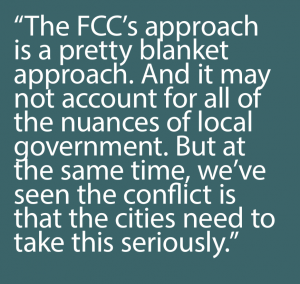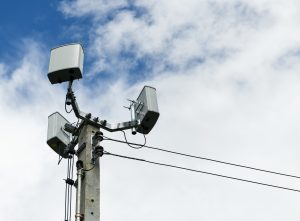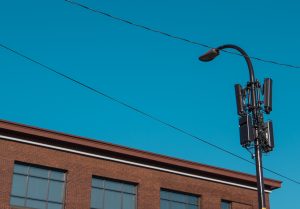Small cells, big uncertainties
Like the turning of a page, Sept. 27, 2018, opened into a new chapter in local telecommunication systems regulation in the U.S.
That day, the Federal Communications Commission (FCC) released an order that drastically altered the way local governments can administer small wireless telecommunication facilities, otherwise known as “small cells,” which enable technology such as 5G.
Among other mandates, the rules prevented local governments from establishing certain requirements on small cells. Notably, the order doesn’t grandfather in past state and local regulations that are out-of-line with the new order.
The FCC justified the order in stating its intent to remove regulatory hurdles towards implementing 5G-related systems, according to an official news release. This intent comes as part of its “commitment to ensuring that the United States wins the global race to 5G.”
Many advocates for local governance, however, have publicly lambasted the order, denouncing its pre-emption of local power.
“The FCC’s impractical actions will significantly impede local governments’ ability to serve as trustees of public property, safety and well-being. The decision will transfer significant local public resources to private companies, without securing any guarantee of public benefit in return,” the National Association of Counties (NACo) and the National League of Cities (NLC) wrote in a joint statement on the FCC’s order.
Challenges to the FCC’s order are moving through Congress and the U.S. judicial system. However, wireless system companies like Verizon and AT&T have begun deploying small cells to cities across the country. Moreover, the FCC set a deadline of April 15 for local governments to publish updated aesthetic standards for small cells that fall in line with the new order.
“The FCC’s approach is a pretty blanket approach. And it may not account for all of the nuances of local government. But at the same time, we’ve seen the conflict is that the cities need to take this seriously,” notes David Witkowski, executive director of civic technology initiatives at Joint Venture Silicon Valley, a nonprofit organization that convenes Silicon Valley leaders across sectors to solve various regional issues together.
Now that the deadline has passed, what can local governments do to manage these systems and their deployment?
To answer, it helps to know exactly what they’re dealing with.
Issues at hand
 A cell tower is hard to miss if you’re around one. Sometimes disguised as trees, the lofty spires send and receive data to and from devices across a wide radius, according to a report from CTIA, an association that represents the U.S. wireless communications industry. Data transmission is naturally strongest near a tower (also called a macro cell) and weakest at its transmission radius’ edge.
A cell tower is hard to miss if you’re around one. Sometimes disguised as trees, the lofty spires send and receive data to and from devices across a wide radius, according to a report from CTIA, an association that represents the U.S. wireless communications industry. Data transmission is naturally strongest near a tower (also called a macro cell) and weakest at its transmission radius’ edge.
Small cells predictably are smaller installations of radio equipment —typically about the size of a pizza box — that transmit data in a much tinier radius. In this way, they’re effective for densely populated areas like city cores, according to a report from Verizon. They’ve even been deployed already to enhance 4G LTE coverage.
Over a 5G network, information is transmitted via millimeter waves, which allow more data to be transmitted in less time but cannot travel as far as waves used in 4G networks, according to a NACo report. Small cells enable the transmission of millimeter waves, but many are needed in close vicinity to ensure that devices in transit receive undisrupted coverage.
Given their size, small cells are frequently placed on public property or in local public rights-of-way, the NACo report explains.
This creates a number of issues. For starters, small cells aren’t the prettiest objects. Improperly disguised small cells could look out-of-character for culturally-distinct areas like the French Quarter in New Orleans or in San Francisco’s Haight-Ashbury district.
“[There is] the potential for… the creation of blight in otherwise beautiful neighborhoods,” says James Kennedy, founder and CEO of Steepsteel, which facilitates the management and consulting of wireless agreements and infrastructure. “That’s something that cities… they have great planners and they have these ordinances, aesthetic guidelines for all kinds of things, and then to get caught flat-footed on this, you could see how that could be detrimental.”
The relocation of wireless equipment into densely-populated areas has forced cities to rethink how they administer it, Witkowski says. Small cells can’t be disguised as trees, and unlike cell towers, they’ll need to be placed in residential areas.
“A city that is used to doing a [cell] tower every 10 years probably can do that through real estate or economic development, some other entity,” Witkowski explains. “Now, it’s falling largely in the bucket of public works. Previously, public works was not really involved in telecom because towers were not in public rights-of-way.”
Public works officials, however, most likely don’t have telecom expertise. So, another issue develops —a learning curve towards knowledge of telecom. But Witkowski says that knowledge of telecom isn’t common among many municipal leaders in general.
“Cities are really good at streets and parks and sidewalks and tree trimming and permits for house additions. They’re just not up-to-speed on telecom,” he explains. “What we find is that most cities don’t have that expertise in-house, and it’s also hard to hire.”
These issues have been compounded especially by cities now needing to construct rules that are in-line with the FCC’s sweeping and restrictive September 2018 order, the Declaratory Ruling and Third Report and Order.
Rules of the game
In its Declaratory Ruling and Third Report and Order, the FCC defines small cells (referred to within as small wireless facilities or SWF) and places a number of restrictions on state and local governments that try to manage the deployment of small cells, according to a document from the National Association of Telecommunications Officers and Advisors (NATOA).
For starters, the order caps all recurring and non-recurring fees related to small cells; the caps can only be raised if local governments can show that the costs are reasonable approximations of reasonable costs levied on the government, the NATOA report states.
“It shifts away all the financial benefit, reduced it by, 80 to 90 percent relative to what it was prior to the passage of this order,” Kennedy explains. “But this is very specific. It’s for assets that are on city property or the public right-of-way, right? So, it’s just going to incentivize carriers and tower companies to put their small cells on government-owned property.”
The order pre-empts local governments from establishing certain aesthetic requirements for small cells. Aesthetic requirements are allowed only if they are “reasonable,” “objective” and aren’t more arduous than requirements put on other infrastructure deployments. The rules must also be published in advance. The order also pre-empts the requirements of all small cells being placed underground or being placed underground in a way that inhibits service.
“Other than safety issues, the rights-of-way are deregulated… [the FCC has] granted [carriers] unfettered and effectively unregulated [access] to the rights of way to install and deploy poles and wireless equipment with minimal at best local oversight,” says Rusty Monroe, founder and owner of Monroe Telecom Associates, which assists local governments in their dealings with the wireless industry. “And they’re doing great harm.”
Lastly, the order establishes “shot clocks” of 60 or 90 days for approvals of small cell deployments. A few actions can pause or stop these shot clocks, but inaction during a shot clock window is considered a violation of the Communications Act.
While the FCC’s order is restrictive, it can also be detrimental to local governments in its vagueness.
“The FCC order uses terms like ‘reasonable’ and doesn’t define those. And ultimately, even on what’s considered the most concrete part of the order, where it talks about fees, it doesn’t say that those are definitely fee caps or that those fees are definitely acceptable,” explains NLC Principal Associate for Technology and Communications Angelina Panettieri.
Tools of the trade

Small cells like the ones on this pole, will be deployed throughout the country to build 5G networks.
Before the FCC’s order was passed, the NLC released a report, “Small Cell Wireless Technology in Cities,” that explains small cell technology, profiles several cities’ small cell-related efforts and presents strategies for city leaders. The first strategy is to become familiar with the technology and its safety considerations.
“These are not simple topics. And so, the challenge I think is, telecom is complex enough that a city really unless they’ve staffed up…the others would have to hire consultants,” Witkowski says.
It is feasible that carriers like Verizon or AT&T could honor aesthetic guidelines that a city passes after April 15, as long as the city provides those guidelines before application discussions begin.
Witkowski provides the example of a carrier entering a city without aesthetic guidelines in place. If the city were to say that it would provide the guidelines at a specific date within a reasonably quick timeframe, he posits that a carrier would most likely honor that agreement.
“I think carriers don’t want a fight. I don’t think the industry wants a fight. They’re not looking to make enemies,” he says. “It would be rational for them to say, ‘OK fine, we’ll give you that amount of time’.”
Panettieri notes that resident involvement was a common theme among the cities profiled in the NLC report. Officials were working with homeowners associations, neighborhood commissions and other groups of residents that were likely to be concerned with small cells. “Proactively working with residents, I think that’s a huge one,” she says.
The shot clocks are particularly important for this strategy, she says. That’s due to the need to keep residents and resident groups abreast of planning processes and to ensure feasible input on placement and designs, as the shot clocks can prevent officials from adequately doing so once time becomes critical.
Monroe believes that the best way to draft up such guidelines is to have a person or team draft them who knows the industry from the inside. He believes that if aesthetics guidelines are drafted up correctly, that they can protect the public in the majority of instances.
“The key is in having well-done regulations by someone who knows what’s happening and how to deal with it,” he says.
Going it alone can be dangerous — Monroe adds that local officials trying to work with the communications industry as equals is, “an effort in futility without expert assistance. They don’t even know what they don’t know.”
Panettieri however, believes that entering into agreements with carriers is a viable option. “Proactively speaking with providers, if [officials] know that they’re a city that’s going to see development, it ensures that they at least have some time to think through what they might be able to come to an agreement on.”
Two cities in particular so far, have been able to obtain desired outcomes in negotiating directly with carriers.
Working together
Instead of rallying against the FCC’s rules, San Diego officials decided to work with Verizon to accelerate small cells’ deployment in the city and improve its technological initiatives.
“We went ahead and took a little bit of a different approach even though we were taken aback a little bit by the FCC rules that came out,” says San Diego Assistant Chief Operating Officer Ron Villa. “But we decided to… embrace the potential that is 5G rather than try and fight everything.”
Announced on April 8, San Diego’s agreement with the city involves the city working with Verizon to streamline its permitting process to lower review times and deploy small cells quicker and more efficiently, according to a news release from the city. San Diego will develop a master permit for digital fiber installation to give more users access to broadband.
“Our development services department that handles all of our permitting… they really came together,” Villa says. “They put a core group of folks together that really started looking at what they did and what they could do with regard to reviewing this, and they took the review cycles from months down to weeks, if not days.”
In return, Verizon will give 500 smartphones to the San Diego Police Department and 50 tablets to the San Diego Fire-Rescue Department, according to the release. Verizon will also install traffic gathering and sensing technology at five intersections where crashes are common, and it will inventory about 60,000 city light poles to provide wireless capability to residents. The carrier will also deploy fiber and small cells to the light poles.
Villa admits that San Diego embraces technology, but that officials also keep the public’s best interest in mind. While concerns about privacy must be addressed, the government has the public trust in them. “San Diego tends to get out in front of some of these things,” he says.
At the end of 2018, Syracuse, N.Y. found itself with a standing small cell-related ordinance that didn’t comply with the FCC’s new order, Syracuse, N.Y. Chief Data Officer Sam Edelstein says.
Realizing that federal rules governing small cells could change again in the future, Syracuse officials decided to rescind their standing order, Edelstein says. Instead, the city would negotiate directly with each carrier as it entered the city until a larger enterprise agreement could be put into place that would govern the city as a whole, Edelstein says.
One concern that has been raised about 5G and small cells concerns the health effects that the technology and the frequencies it emits would have on the public. An agreement between Syracuse and Verizon has enabled the city to address those concerns while having small cells implemented in its community.
“Because there hasn’t been tons of research into the effects of having radio frequencies that 5G provides, it would be good to have regular checks on those antennas,” Edelstein says. “But then additionally, we knew that people would be nervous about them… we wanted to ensure that we could check on that to give some more confidence to the public that not just anything can go into facilities that can emit whatever kind of radio frequencies that the carrier wants.”
Another critical part of the agreement was ensuring that the city would have an equitable level of connectivity deployed across its area, since certain parts of the city lack internet access, Edelstein says.
The desire to inspect the small cells hadn’t been asked of Verizon before, Edelstein says. However, Verizon was confident that health wouldn’t be an issue because they do their own testing of the cells. The city is still determining how exactly it will carry out small cell inspections, but officials have thought about it in a similar way to how inspections of other pieces of infrastructure are carried out.
“We are excited about the technology and think it’s also our job to find ways to provide access to the right-of-way in a safe and responsible way,” Edelstein says. “And so, we feel like we did that with this agreement.”
There is much to be excited about as far as 5G is concerned — especially because it will enhance far more than mobile handset connectivity.
Close to the cutting edge
The deployment of 5G will certainly carry technological benefits to cities, but it will also yield economic benefits.
A report from Accenture indicates that U.S. carriers and telecom operators could invest about $275 billion over seven years to deploy small cells and other next-generation wireless technology. This, in turn, is expected to create 3 million jobs and lead to $500 billion in gross domestic product (GDP) growth.
Witkowski explains that 5G is simply the next incremental step in a better performing network — it’s not akin to simply flipping a switch on a new technology. However, 5G networks are more flexible in that they don’t just offer technological benefits for mobile handsets.
5G will improve fixed wireless, mobile technology, weightless positioning, the Internet of Things (IoT) and more efficient use of spectrum, Witkowski says. The Accenture report states that 5G will allow the high-speed, pervasive connection of more devices and sensors, and it will provide better redundancy and reliability with low power consumption.
An example of improvement for cities lies in GPS efficiency — 5G and small cells will improve that efficiency in dense urban areas where buildings can reflect GPS signals, Witkowski says. This, along with enhanced vehicle-to-vehicle communications via 5G, can improve the use of autonomous vehicles.
However, the 5G that has been launched isn’t necessarily up to par with what the technology promises. For example, AT&T has launched what it calls 5G Evolution (5Ge) in 400 markets, but that technology runs on its existing LTE network, according to an AT&T statement.
So, regarding both the launch of 5G and the concrete benefits it will bring to cities, governments may have to play the waiting game for the time being.
“I think it’s kind of a wait-and-see situation,” Panettieri says. “Because if the technical benefits of 5G include lower latency and higher network load, then potentially, this is going to be most effective for those smart city Internet of Things deployments where you’re dealing with a lot of devices on a network over a short distance.”






















The U.S. Brain Tumor Association states that within the radio frequency portion of the electromagnetic spectrum, the higher the frequency, the more dangerous the radiation. Previous cellular generations emit 1 to 6 KHz frequencies. 5G cell tower emissions emit as high as 300 GHz.